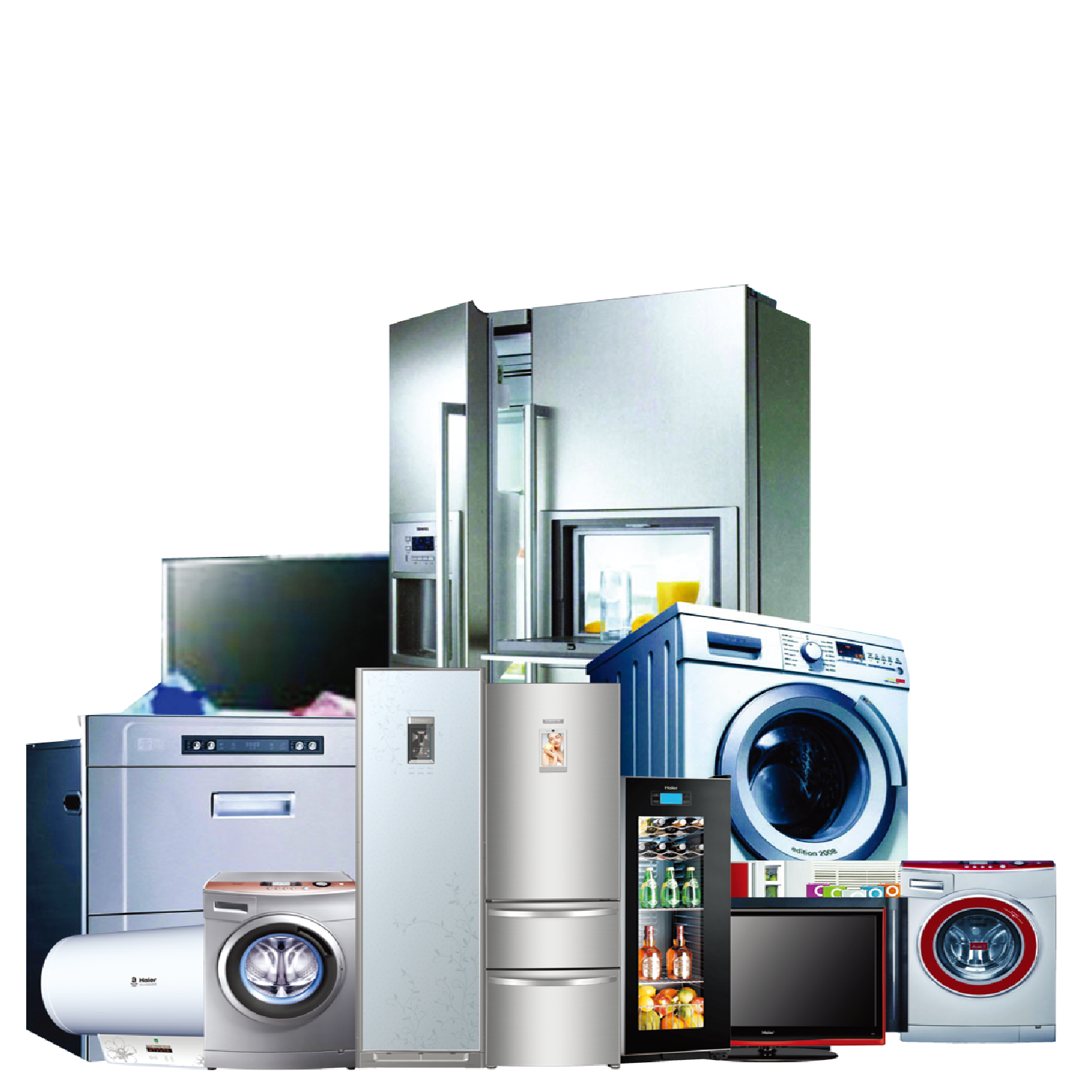Cooler unit & fans
The three included 120 mm Aurora Rise fans run at a maximum speed of 2500 rpm. A corresponding 4-pin splitter cable is included for fan control wiring, which splits into three ends. Thus, the control via the mainboard works flawlessly. The pump, on the other hand, runs at a fixed speed of 2600 revolutions per minute. Alphacool additionally specifies a tolerance of +/- 10%. The pump unit holds the DC-LT 2 pump, which is an improved version of the DC-LT low noise pump from Alphacool. The bottom of the cooler is made of nickel-plated copper and the entire cooler unit offers a maximum flow rate of 75 liters per hour.
Преимущества и недостатки СВО для компьютера – справка редакции Zuzako
Открытая (кастомная) и закрытая СВО является альтернативой стандартным кулерам. Такой охладитель оснащается насосом, который способствует циркуляции жидкости через водоблок, присоединённый к процессору ПК. Последний нагревается во время работы и отдаёт своё тепло воде. Далее жидкость поступает в специальный радиатор, который охлаждает её и возвращает в систему. Этот процесс повторяется до тех пор, пока не будет отключено питание ПК. Простота конструкции и понятный принцип работы устройства являются далеко не единственными достоинствами СВО.
Преимущества системы водяного охлаждения:
Высокая эффективность. СВО хорошо отводит и рассеивает тепло. Это объясняется тем, что теплопроводность воды достигает более высоких показателей, чем у воздуха, используемого в стандартных системах охлаждения. Всё это положительно сказывается на работе процессора и повышает его срок эксплуатации.
Низкий уровень шума. Все проводимые тесты показывают, что СВО работает намного тише, чем кулер
Издаваемый ею шум не мешает пользователю концентрировать своё внимание на выполнении различных задач, предусматривающих использование ПК.
Универсальность. С помощью СВО можно охладить не только процессор, но и многие другие компьютерные комплектующие (например, видеокарта, жёсткий диск, блок питания и др.).
Красивый внешний вид
Системы водяного охлаждения часто оснащают светодиодной подсветкой, которая всегда выглядит эффектно и даёт возможность пользователю выделить свой компьютер на фоне других ПК.
Компактность. СВО занимают мало места в системном блоке. Благодаря этому пользователь может использовать более узкие корпуса и экономить место на компьютерном столе.
Главные недостатки:
- Высокая цена. Большинство систем водяного охлаждения стоят дорого. Особенно высокой становится цена, если сравнивать её со стоимостью обыкновенных кулеров.
- Сложности при монтаже. Далеко не все пользователи смогут успешно установить СВО в системный блок своего компьютера. Из-за этого им придётся прибегать к помощи специалистов и нести дополнительные финансовые потери.
- Вероятность утечки жидкости. Износ системы и различные механические воздействия могут привести к утечке воды. Такая неисправность чревата серьёзными последствиями, вплоть до полной поломки компьютера.
- Необходимость регулярного обслуживания. СВО не будет эффективно работать, если за ней тщательно не ухаживать. Поэтому пользователю придётся периодически сливать и очищать жидкость, а также пополнять запасы постепенно испаряющейся воды.
Lighting
The lighting of the individual components can really be seen. The fans consist of a two-part lighting circuit. An outer ring and the illuminated fan center. From the center shine the individual colors to the individual blades. The illuminated ring can even be seen from the side profile of the fans and offers a spectacular effect, especially for open cases. No extra RGB controller is included for wiring the lighting. The fans are simply wired in series and then connected to the case’s motherboard or RGB controller using the 5V ARGB connector.
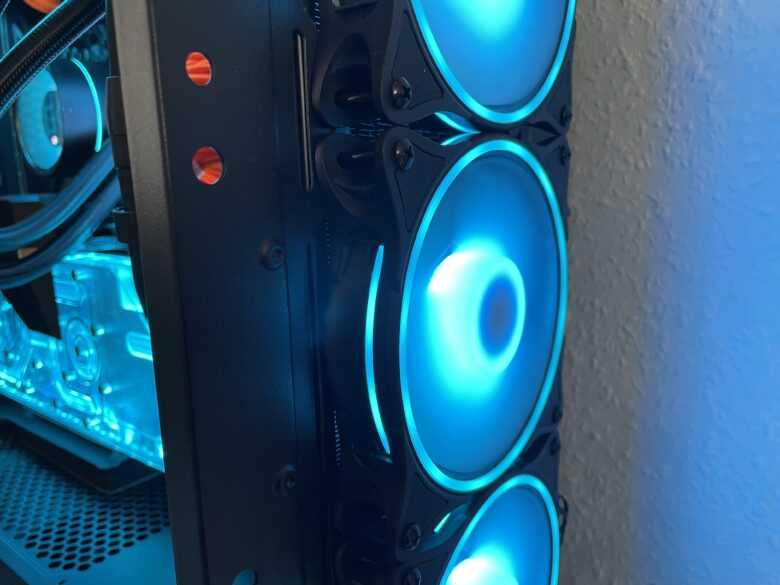
The illumination of the cooler unit is also quite impressive. The light spectacle is provided by an LED strip, which was incorporated on the lower side (the side that faces the motherboard when installed). The LED band includes a total of 14 LEDs. Each LED is capable of displaying a different color (addressable RGB). Thus, not only static colors, but also color gradients or effects, such as the well-known rainbow, can be displayed. The light shines through to the front side (visible side). The vertical installation of the GPU is recommended, as the lighting really comes into its own here and you can’t take your eyes off the inside of the PC.
No separate program is needed for the lighting. The entire control is possible via the software of the respective motherboard manufacturer or, as in our test, via the RGB controller of the case. If neither is available, Alphacool offers an RGB controller, which is powered via the Sata port (Alpha Cool Aurora Eiscontrol*).
Assembly
As mentioned at the beginning of our review, the tested version, is the one compatible for the Radeon RX 6900 XT. With the upgrade, we expect a gain in aesthetics and cooling performance. We would also like to see a less massive look after the upgrade.
The first steps for the conversion are to prepare and disassemble the graphics card case. Start by unscrewing all the screws on the back (backplate) of the GPU. In addition, it is necessary to unscrew the screws below the display connectors, otherwise the case cannot be removed.
If the bare PCB is now in front of you, it’s a matter of removing the old cooling pads and thoroughly cleaning the processor surface. Afterwards, the thermal paste is applied to the GPU and the 1mm cooling pads are glued to the corresponding points. You can find out where the pads have to be attached from the clear installation instructions.
Next, the cooling unit is placed on the PCB and fastened with screws on the back. Make sure that the cooling unit is free of fingerprints or dirt. Especially on the Plexiglas you will regret not having worked cleanly as soon as you turn on the illumination.
The next step is to attach the 3mm pads to the back of the GPU. The positions can also be taken from the assembly instructions. After that, the included backplate is put on and screwed to the cooling unit. With that, the conversion is complete and we are ready for our performance test.
Scope of delivery
Delivered is the Eiswolf 2, as it is known from AiO water cooling systems. Heatsink and radiator are connected with two hoses. Only the fans still have to be mounted on the radiator. Besides the water cooling itself, various screws for mounting on the corresponding GPU are included. Cooling pads, which are needed for the conversion, have also been thought of. They are already cut to size and only have to be glued onto the intended places. The pads can be differentiated in thickness, the ones for the backplate are 3 mm thick and the pads for the cooler only measure 1 mm in thickness. In addition to the cooling pads, a thermal paste is also included, which is needed for the graphics processor.
When it comes to fans, the Eiswolf 2 relies on the Alphacool Rise Aurora. Three 120 mm fans, which decorate the data sheet with a speed of up to 2500 revolutions per minute. Features the Aurora with a nice RGB lighting, which we will go into more detail later in this review.
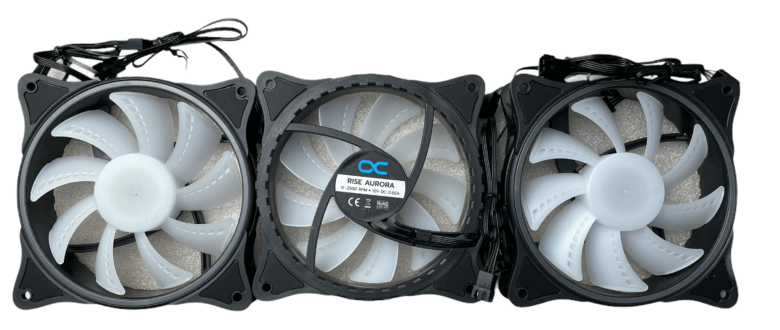
The Eiswolf 2 comes with a backplate, which is included with the purchase. It is delivered in a separate packaging, which is included in the outer packaging. The design is a noble black, which makes a slightly textured and matte impression. The OC logo has been incorporated into the bottom right corner. The cooling pads for the backplate are also included and already cut to size. At which points these have to be placed is explained well and with pictures in the assembly instructions.
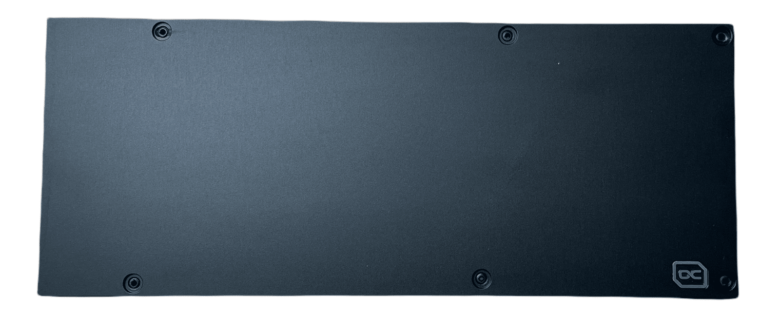
Performance test
For our performance test, the RX 6900 XT found a place in the following test system along with the Eiswolf 2:
- Processor: Ryzen 5 3600*
- Mainboard: MSI MPG B550 Gaming Carbon WiFi*
- Memory: Corsair Vengeance RGB PRO*
- Graphics card: AMD Radeon RX6900 XT
- Power supply: Corsair HX 850*
- AiO: Deepcool Castle 240EX*
- Case: Antec Dark Fleet DF600 Flux*
- Cables: LINKUP – PSU Cable Extensions*
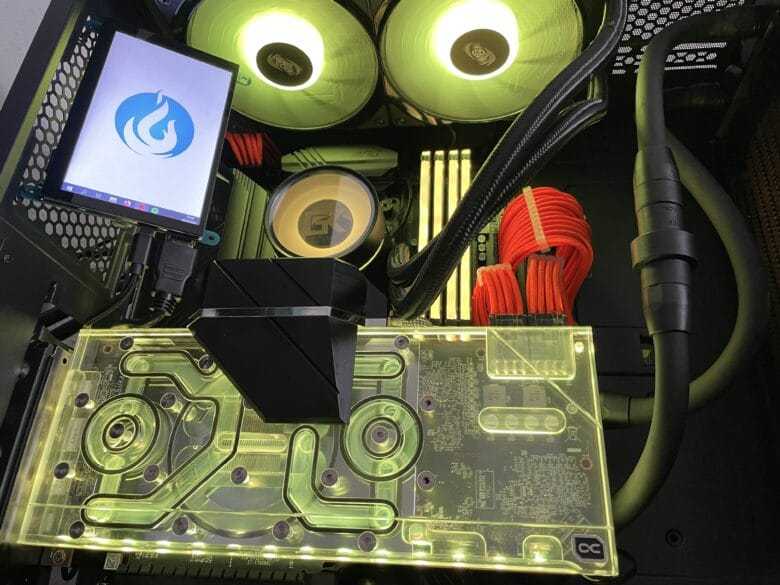 For our performance test, we loaded the RX 6900 XT with the 3DMark Firestrike stress test. The goal was to push the temperatures of the graphics card upwards. In order to get a comparable value, we used the standard version of the Firestrike stress test. The resulting temperatures refer to the graphics card with the original heatsink and to the conversion with the Eiswolf 2. You can see the resulting temperatures in the table below.
For our performance test, we loaded the RX 6900 XT with the 3DMark Firestrike stress test. The goal was to push the temperatures of the graphics card upwards. In order to get a comparable value, we used the standard version of the Firestrike stress test. The resulting temperatures refer to the graphics card with the original heatsink and to the conversion with the Eiswolf 2. You can see the resulting temperatures in the table below.
| Fan power | GPU temperature (°C) – reference | Temperature GPU (°C) – Icewolf 2 |
| 50% PWM | ∅ 70.0 / max. 73.0 | ∅ 56.0 / max 59.0 |
| 100% PWM | ∅ 67.0 / max. 70.0 | ∅ 52.0 / max 54.0 |
As expected, the temperatures turn out a lot better after the upgrade. At 50% fan power, the average value is 56 °C, which is about 14 °C cooler than with the stock heatsink. Alphacool already promises on the website, the cooling performance of a custom water cooling and that with an all-in-one design. In our opinion, they have kept this promise, even though the temperatures should be even better with a custom water cooler. Simply because of the larger cooling circuit. Nevertheless, the Eiswolf 2 could convince!
Design and construction
The Eiswolf 2 was equipped with a powerful 12V pump, which is located directly on the heat sink. The case of the pump is largely kept in black. A metallic application visually separates the pump from the heat sink. On the front of the pump housing, depending on the model, the graphics card manufacturer has been included. The logo is illuminated in red or green, depending on the manufacturer. The color of the illumination is fixed and cannot be changed. The lettering “Eiswolf” is not illuminated and therefore rather inconspicuous.
For the radiator, Alphacool relies on a version from the NexXxos series, which is made almost entirely of copper. Only the outer casing is made of stainless steel and the cooling fins, pre-chambers and cooling channels are made of copper. This promises excellent thermal conductivity and contributes significantly to the cooling performance. There are screw points for up to six fans on the case of the radiator. In total, the 360-mm radiator offers space for three 120-mm fans per side.
The great feature of the Eiswolf series is that it can be linked with the Eisbaer Aurora, an AiO for processors from Alphacool, giving the advantage of a larger water circuit. So the processor cooler and graphics cooler then share two radiators and an overall larger amount of coolant. Alphacool’s goal here was to create an AiO water cooling system with the performance of a custom water cooling system. Expanding is convenient via the quick disconnects on the hoses. To protect against leaking liquid, the quick disconnects are not just plugged together, but screwed tight. The hoses are with 50 cm length sufficiently long and thus offer enough possibilities to lay them neatly in the case.
Conclusion
The conversion from the stock cooler to Alphacool’s all-in-one solution was not only a lot of fun, but also brings a meaningful upgrade. The tested temperatures speak for themselves. The conversion went without complications and was very well described. Quality and workmanship are very consistent. Even if we noticed the hoses in their condition somewhat negatively, a lot of love was nevertheless put into the detail. The expandability of the cooling circuit with Alphacool products is also very well received by us and offers the user more options to get a bit closer to custom water cooling.
For €244.99 (MSRP) you not only get better cooling performance, but also a massive visual upgrade for your gaming PC. Real custom water cooling feeling and that without complicated installation.

